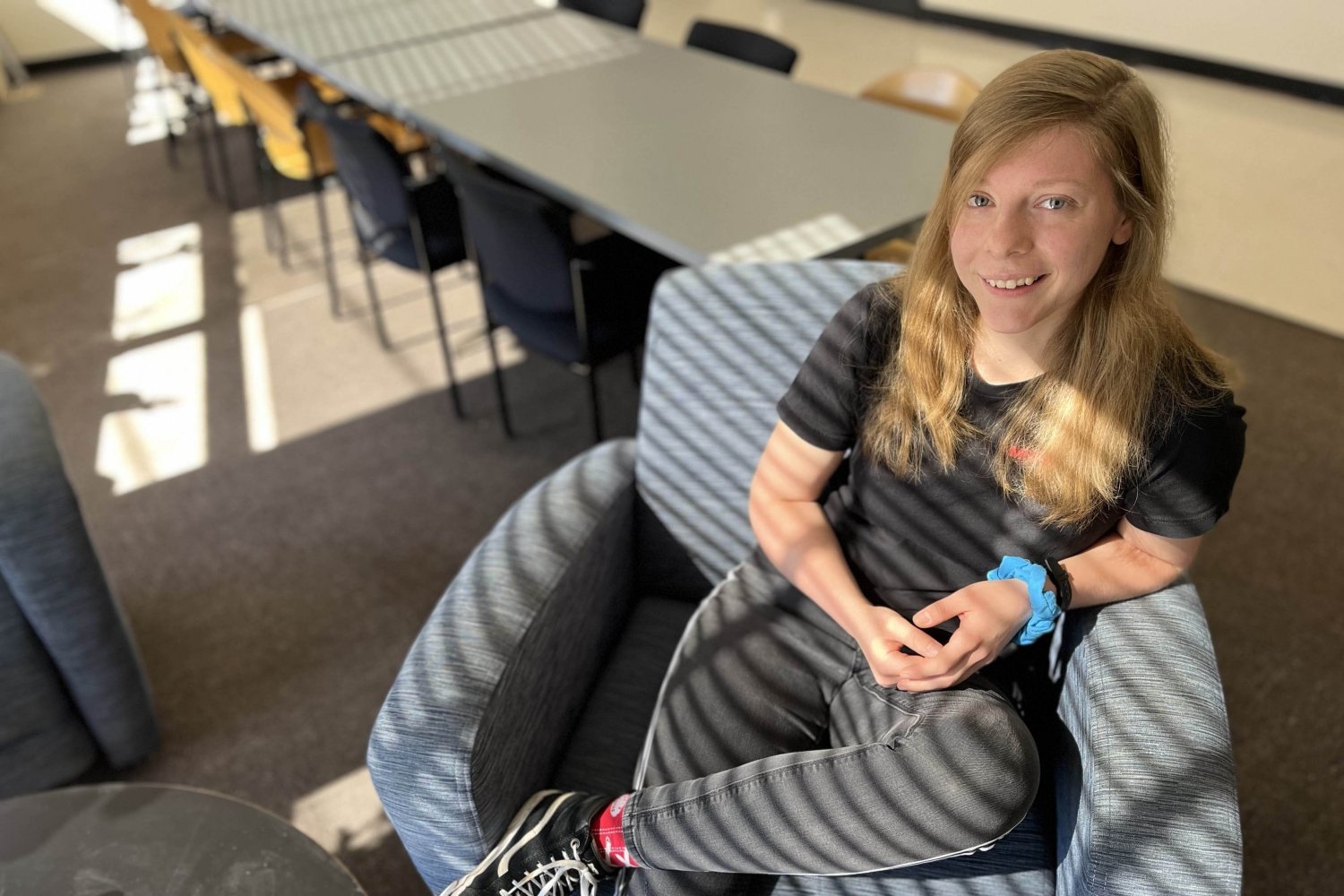
Graduate student Skylar Dannhoff discovers the collaborative world of fusion research.
Paul Rivenberg | Plasma Science and Fusion Center
Skylar Dannhoff knew one thing: She did not want to be working alone.
As an undergraduate at Case Western Reserve University, she had committed to a senior project that often felt like solitary lab work, a feeling heightened by the pandemic. Though it was an enriching experience, she was determined to find a graduate school environment that would foster community, one “with lots of people, lots of collaboration; where it’s impossible to work until 3 a.m. without anyone noticing.” A unique group at the Plasma Science and Fusion Center (PSFC) looked promising: the High-Energy-Density Physics (HEDP) division, a lead partner in the National Nuclear Security Administration’s Center for Excellence at MIT.
“It was a shot in the dark, just more of a whim than anything,” she says of her request to join HEDP on her application to MIT’s Department of Physics. “And then, somehow, they reached out to me. I told them I’m willing to learn about plasma. I didn’t know anything about it.”
What she did know was that the HEDP group collaborates with other U.S. laboratories on an approach to creating fusion energy known as inertial confinement fusion (ICF). One version of the technique, known as direct-drive ICF, aims multiple laser beams symmetrically onto a spherical capsule filled with nuclear fuel. The other, indirect-drive ICF, instead aims multiple lasers beams into a gold cylindrical cavity called a hohlraum, within which the spherical fuel capsule is positioned. The laser beams are configured to hit the inner hohlraum wall, generating a “bath” of X-rays, which in turn compress the fuel capsule.
Imploding the capsule generates intense fusion energy within a tiny fraction of a second (an order of tens of picoseconds). In August 2021, the National Ignition Facility (NIF) at Lawrence Livermore National Laboratory (LLNL) used this method to produce an historic fusion yield of 1.3 megajoules, putting researchers within reach of “ignition,” the point where the self-sustained fusion burn spreads into the surrounding fuel, leading to a high fusion-energy gain.
Joining the group just a month before this long-sought success, Dannhoff was impressed more with the response of her new teammates and the ICF community than with the scientific milestone. “I got a better appreciation for people who had spent their entire careers working on this project, just chugging along doing their best, ignoring the naysayers. I was excited for the people.”
Dannhoff is now working toward extending the success of NIF and other ICF experiments, like the OMEGA laser at the University of Rochester’s Laboratory for Laser Energetics. Under the supervision of Senior Research Scientist Chikang Li, she is studying what happens to the flow of plasma within the hohlraum cavity during indirect ICF experiments, particularly for hohlraums with inner-wall aerogel foam linings. Experiments, over the last decade, have shown just how excruciatingly precise the symmetry in ICF targets must be. The more symmetric the X-ray drive, the more effective the implosion, and it is possible that these foam linings will improve the X-ray symmetry and drive efficiency.
Dannhoff is specifically interested in studying the behavior of silicon and tantalum-based foam liners. She is as concerned with the challenges of the people at General Atomics (GA) and LLNL who are creating these targets as she is with the scientific outcome.
“I just had a meeting with GA yesterday,” she notes. “And it’s a really tricky process. It’s kind of pushing the boundaries of what is doable at the moment. I got a much better sense of how demanding this project is for them, how much we’re asking of them.”
What excites Dannhoff is the teamwork she observes, both at MIT and between ICF institutions around the United States. With roughly 10 graduate students and postdocs down the hall, each with an assigned lead role in lab management, she knows she can consult an expert on almost any question. And collaborators across the country are just an email away. “Any information that people can give you, they will give you, and usually very freely,” she notes. “Everyone just wants to see this work.”
That Dannhoff is a natural team player is also evidenced in her hobbies. A hockey goalie, she prioritizes playing with MIT’s intramural teams, “because goalies are a little hard to come by. I just play with whoever needs a goalie on that night, and it’s a lot of fun.”
She is also a member of the radio community, a fellowship she first embraced at Case Western — a moment she describes as a turning point in her life. “I literally don’t know who I would be today if I hadn’t figured out radio is something I’m interested in,” she admits. The MIT Radio Society provided the perfect landing pad for her arrival in Cambridge, full of the kinds of supportive, interesting, knowledgeable students she had befriended as an undergraduate. She credits radio with helping her realize that she could make her greatest contributions to science by focusing on engineering.
Danhoff gets philosophical as she marvels at the invisible waves that surround us.
“Not just radio waves: every wave,” she asserts. “The voice is the everywhere. Music, signal, space phenomena: it’s always around. And all we have to do is make the right little device and have the right circuit elements put in the right order to unmix and mix the signals and amplify them. And bada-bing, bada-boom, we’re talking with the universe.”
“Maybe that epitomizes physics to me,” she adds. “We’re trying to listen to the universe, and it’s talking to us. We just have to come up with the right tools and hear what it’s trying to say.”
